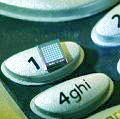System on a
Chip (SOC)
“System on a Chip”, or
SOC, refers to the integration of all
the necessary electronic circuits of diverse functions onto a
single chip, to come up with
a complete
electronic system that performs the more complex but more useful final
product function. Thus, instead of building an electronic product
by assembling various chips and components on a circuit board, SOC
technology will allow all of these parts to be
fabricated together
on a single chip, which can function as the final product itself.
For instance, an SOC for electronic control of an automobile's
suspension system will have the following distinct parts: 1) an
accelerometer for
detecting
the car's motion; 2) an ADC for
converting
the accelerometer's analog output into digital data; 3) a digital signal
processor for
analyzing
the digital data; 4) and an output driver system for
controlling
the mechanical behavior of
the suspension system. In an SOC, all of these functionally
individual circuits will be contained on a single integrated circuit.
System-on-a-Chip (SOC) must not be confused with
System-in-a-Package (SIP), which
is a device that consists of multiple individually fabricated chips that
make up a complete electronic system housed in a single package. Thus,
SIP pertains to an advanced type of packaging technology, while SOC
deals with microchip fabrication technology.
The
advantages
offered by SOC technology include: 1) higher performance, since
all the circuits will be on a single chip; 2) smaller space
requirements; 3) lower memory requirements; 4) higher system
reliability; and 5) lower consumer costs.
The
challenges posed by SOC
technology include: 1) larger design space; 2) higher design and
prototyping costs; 3) longer design and prototyping cycle time; 4) more
complex debugging; 5) lower IC yields and higher wafer fab costs due to
the relatively larger die sizes involved; 6) integration of intellectual
property from multiple (and possibly independent) sources.

Figure 1. An acoustic
SOC from Akustica, Inc. composed of
microphones, support
electronics, and software on a standard
CMOS chip; source: http://www.archive.chipcenter.com
Aside from these challenges,
the task of
electrically testing
SOC's is daunting as well. Automatic
testers today are built along specific specialty areas, and only the
most expensive test systems cater to a wide variety of device
technologies. An SOC, in essence being composed of many different
devices, requires a test system that can perform electrical testing on
all its analog and digital circuit components. SOC testing,
therefore, generally requires high-end and consequently more expensive
ATE systems.
Due to the complexities and
high costs of developing viable SOC technologies, even large
semiconductor companies have opted to
co-develop SOC-based products with
partner companies instead of going about it on their own. For
instance, Motorola, Philips and STMicroelectronics have started working
together with TSMC to develop SOC processors that will power a wide
variety of products - from set-top boxes to MP3 players to networking
equipment.
IBM has also formed an
alliance
with Sony and Toshiba to create a new SOC processor
architecture called Cell, which are expected to end up in Sony's
PlayStation 3 game console. AMD, on the other hand, has formed its
'Personal Connectivity Solutions' group, which will focus on SOC's for
home-networking products. Intel is doing the same thing with its
XScale processor.
SOC
development is a complicated activity that encompasses many disciplines,
from
circuit
design
to
thermal
management
to
test
engineering.
Building an SOC from the design library of your own company is one
thing, building one from several design libraries from different
suppliers is another. Making the various blocks from these
different design libraries work together, even if they're
not
designed to be
compatible
with each
other in the first place, is indeed a big challenge by itself already.
A high level
of
design reuse
among design groups is needed to attain high productivity rates in SOC
design. A common approach for design reuse is
'source
reuse',
which consists of reusing designs created elsewhere. Unfortunately,
source reuse is not a very effective system in many cases, since it
still involves understanding and redesigning of IP (intellectual
property) blocks on the
part of the SOC designer to make them useable in a new product.
A more
effective reuse methodology, known as
integration-driven reuse,
allows the SOC designer to reuse an IP block without having to make
changes to it. One approach for this is to use an integration platform,
which is an SOC design environment that includes architectural
specifications and pre-qualified IP blocks designed to work together on
that platform. Philips is an example of a semiconductor company that
employs integration platforms to meet their design productivity goals.
Given the high cost of SOC
development, it is certainly not the solution for everything in the
semiconductor industry. SOC may be appropriate for high-volume
production of not-too-complex systems, but not for low-volume production
of complex systems that require different technologies. For the latter
case, SIP may be a
better choice.

